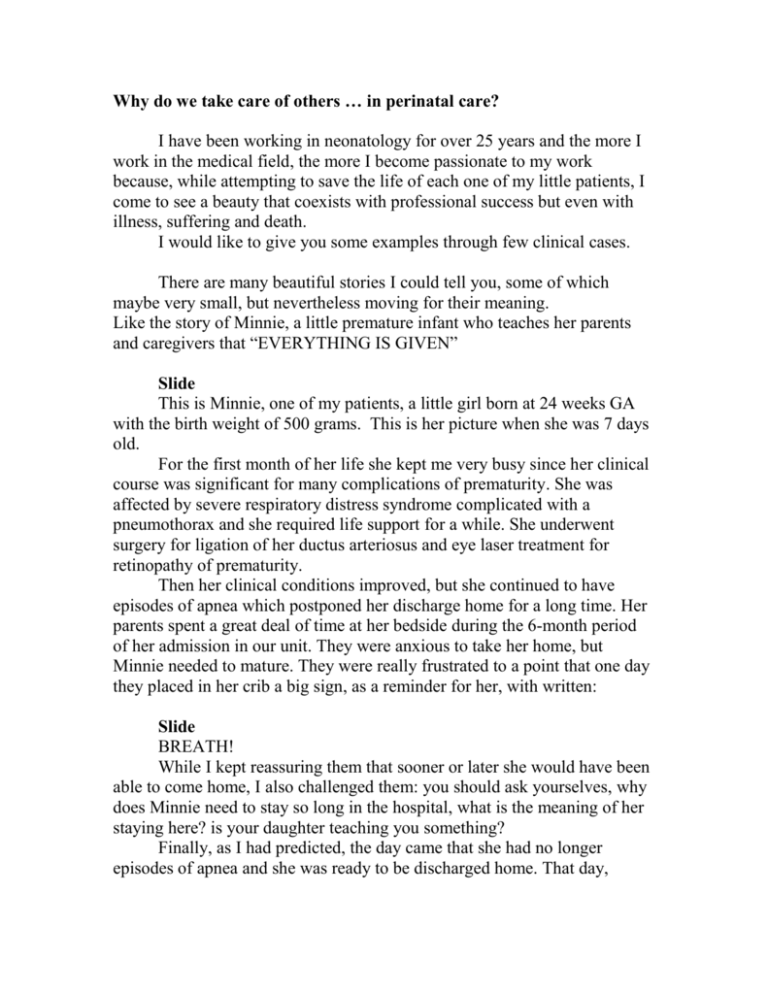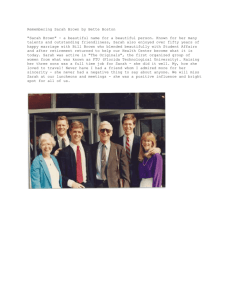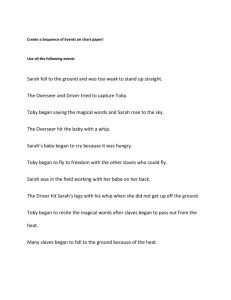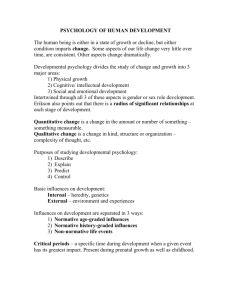Why do we take care of others … in perinatal care
advertisement

Why do we take care of others … in perinatal care? I have been working in neonatology for over 25 years and the more I work in the medical field, the more I become passionate to my work because, while attempting to save the life of each one of my little patients, I come to see a beauty that coexists with professional success but even with illness, suffering and death. I would like to give you some examples through few clinical cases. There are many beautiful stories I could tell you, some of which maybe very small, but nevertheless moving for their meaning. Like the story of Minnie, a little premature infant who teaches her parents and caregivers that “EVERYTHING IS GIVEN” Slide This is Minnie, one of my patients, a little girl born at 24 weeks GA with the birth weight of 500 grams. This is her picture when she was 7 days old. For the first month of her life she kept me very busy since her clinical course was significant for many complications of prematurity. She was affected by severe respiratory distress syndrome complicated with a pneumothorax and she required life support for a while. She underwent surgery for ligation of her ductus arteriosus and eye laser treatment for retinopathy of prematurity. Then her clinical conditions improved, but she continued to have episodes of apnea which postponed her discharge home for a long time. Her parents spent a great deal of time at her bedside during the 6-month period of her admission in our unit. They were anxious to take her home, but Minnie needed to mature. They were really frustrated to a point that one day they placed in her crib a big sign, as a reminder for her, with written: Slide BREATH! While I kept reassuring them that sooner or later she would have been able to come home, I also challenged them: you should ask yourselves, why does Minnie need to stay so long in the hospital, what is the meaning of her staying here? is your daughter teaching you something? Finally, as I had predicted, the day came that she had no longer episodes of apnea and she was ready to be discharged home. That day, before leaving, her parents gave to each one of us, caregivers, stickers that say: Slide “EVERY BREATH IS A GIFT” They told me, we know why Minnie needed to stay all these days in the hospital, we needed time to understand that everything is given. Slide As I said in the beginning, I find moments of beauty even in the midst of severe illness and death, because there is a meaning even there. This is the story of Sarah and in her short life she has taught her parents, and her doctors that in order to understand our destiny we need to FOLLOW REALITY. Sarah was a full term infant born by stat C/section for uterine rupture. At birth she was floppy, with no respiratory effort, and her heart rate was in the 50s. Her pH was 6.8. Despite a vigorous resuscitation, she had suffered a severe hypoxic ischemic insult, she had multi-organ failure. She underwent brain cooling in the attempt of decrease her secondary damage to the brain. By DOL 3 her liver and renal functions were back, however she had no spontaneous respiration and her head MRI showed severe damage of many areas of her brain including the brainstem. I communicated to the family her extremely critical conditions and severe prognosis. The questions of the parents to me were: “will Sarah live? And if she survives how is going to be her life? Will she walk and talk? Will she see?” And eventually the most important question, “will she be happy?” Of course I did not know how to answer all of these questions, no even the first: “will she live?” And I was wondering, how can we – including the parents and myself as caregiver – how can we understand which way we need to go? I looked at Sarah, she was there, given to us in that moment, I understood. This was my proposal to the family: I told them, “See, there is an evidence in reality that everything is given, I am given, you are given, we did not decide when we were conceived, nor we will decide our last day. The same thing is true for Sarah. There is only one way to go, the only way to face this situation and to know what to do is following reality”. So we followed reality, we followed the little Sarah. In the following days, the conclusion of my daily dramatic discussions with this family was always the same: “by today we don’t know, it is not yet clear, the baby will tell us”. Other physicians strongly suggested withdrawing care right away to allow the infant to die and prevent a surviving handicapped child. While Sarah’s mother was totally against this possibility, the father was torn between the thought of losing his daughter versus having a handicapped daughter and he was very close to give his approval. In those first days her prognosis was still very uncertain, so my only certainty was that there was a plan for her life, we just needed to follow reality to identify it. And I continued to insist with them to follow her. Finally, together with the parents we decided that we did not want to “manipulate” Sarah’s destiny, we followed her and we anticipated that her destiny will become clear. She remained on life support. However day after day her clinical conditions continued to deteriorate and by DOL 10 she still had no respiratory effort, her pupils were fixed and dilated, her EEG was almost flat. I understood. I shared with the family my evaluation, I told them: “Sarah is telling us something”. Her heart rate declined rapidly down to zero, within 2 minutes after the life support was taken off. She was in her mom and dad arms. Everybody was in tears, but in peace, because we did not ‘make’ any decision for her. She had had a very short but very intense life, full of love. The parents and grandparents kept embracing me and thanking me – I was wondering, how come? I am the doctor, they should thank me if Sarah had survived! I asked them, why do you thank me? They answered: you allowed us to be mother and father, at least for a short period of time. The mystery of Sarah’s death remains, but yet it was a moment of beauty. Slide The last case I would like to share with you has to do with my activity in a Perinatal Hospice project. Just before telling you the story I would like to take a moment to communicate to you how this project came about, because it was also a moment of beauty. At Columbia University, where I work, I am part of the prenatal pediatrics team and we meet weekly to discuss pregnancies at risk especially for fetal anomalies. When a fetus is diagnosed with a congenital anomaly, most of the time, termination of pregnancy is the only proposed option. My participation to this weekly meeting has been faithful, but also painful, as you can imagine. However, again following reality, something very interesting happened and it was the occasion for me to make a new step in my career. About 2 years ago, at one of these meetings, 3 very unusual cases were presented. All 3 women were expecting infants with lethal congenital anomalies and they had no intention to abort their infants. The obstetricians could not understand these mothers’ decision and were wondering how to manage the cases. I remember, I said, this is it, I raised my hand and I said, I know exactly what to do, it is called comfort care. It is very simple, we just welcome the babies as they are and whether the infant lives 1 hour, 3 hours, few days, whatever long or short their lives will be, we can accompany them till their last day. I’ll be happy of taking care of them. This was a real moment of beauty because for few seconds – a moment of true sincerity – everybody in that room, felt that this plan was the most adequate. One of the obstetricians present, a person who performs and believe in abortion, whispered “it would not be better if all mothers did this way?” Unfortunately did not last for them, but I began. From that day to the present, I have been following a total of 25 pregnancies complicated with lethal condition for the infant. Some were mothers who, after the diagnosis, decided to continue the pregnancy to the end, other mothers came to me for prenatal consult because were diagnosed ‘too late’ for legal abortion. However it is amazing to notice that, whether they decided to ‘keep’ the baby or were somehow ‘obliged’ to continue their pregnancy by the circumstances, when I met with them and I explained my proposal there was no difference in their expectation. When the delivery time comes, each parent wants to know if the baby will suffer, how long the baby will live and if they can hold the baby when is born. In short, in front of their baby parents discover themselves as father and mother. I found this to be a strong evidence of the fact that our heart is one and the need for maternity and paternity is originally the same in every human being. My approach is a proposal: when we meet before the delivery, I say to the parents, this infant is going to have a very short life, and therefore very precious, we have to be prepared to welcome him or her. And we decide together a plan for the delivery and the postnatal care. This plan involves a lot of education of the staff since we work in an intensive care unit. The routine set-up in delivery room is that as soon as a child is admitted, the nurse is ready to place EKG leads and saturation monitors, blood pressure cuff, angiocath for IV fluid, the fellow is ready to intubate or to place arterial lines. All of this is not necessary with comfort care, because no one of these devices or procedures produce comfort, rather they tend to separate the infant from the parents. Believe it or not it is very hard to have the staff people stop all of this and be able to take care of the infant by simply asking: what can comfort this baby? The pillars of comfort care are: warmth, hydration, pain management if indicated and facilitation for the parents and family members to stay with the infant. The last case is one of the most beautiful I can recall, it is about a delivery managed with comfort care in my program of perinatal hospice. A case of literally unexpected beauty. A 16 year old girl was found pregnant with conjoined twin girls. The bodies were joined by the thorax, and they shared a heart with very complex anomalies. A post-natal repair was judged impossible, even with the dramatic choice to sacrifice one of the two infants. To complicate even more the scenario, the mother developed a very severe pre-eclampsia and the infants were delivered at 29 weeks GA. Before the delivery I met this young girl and her boyfriend, they were both 16, 2 kids basically. I anticipated them that, although I cared very much for their babies, their life was going to be very short, since there was no surgical option and the heart they shared was malformed and therefore not capable to sustain a double circulation. Nevertheless their babies were very precious for us and we would have done all we could to make their short life the best possible. Surrounded by obstetricians who blamed the couple for having continued the pregnancy and residents who were looking for their digital cameras to take pictures of the “monster”, I was sincerely moved by the love of these 2 young parents for their babies. Immediately after the C/S the father wanted to hold the two little bodies, which were held in an embrace, since they were united by the heart. The girls were really cute. Then he wanted to wash their bodies, dress them with baby clothes and bring the two little girls to the mother, so she could hold them before their heart stopped. Aware of their slow heart rate, I asked him, do you believe in God? He said yes. I asked then: Do you want me to baptize your babies? He answered yes and he gave me the 2 names: Keela and Kayla. So I wet my hand with water and I started with the one on my left, ‘I baptize you Keela, in the name…’ – he held my hand and he said, no this is Kayla, the other is Keela. Now, I am thinking, come on, they are Siamese, identical girls, what is the difference? But I stopped and began again naming the real Keela as Keela and the real Kayla as Kayla. And I was wondering, for a father each of his children is unique and not replaceable, probably this is the same way the Mystery looks at us. As they had few gasps before the heart stopped, he talked to them in a very sweet manner “daddy is here, don’t worry”. I looked at him holding the babies, this big kid, 16 year old, he could have been a high school student, yet he made a great father. In the mean time in the delivery room, I noticed that everybody was in tears, nurses, obstetricians, how come? Were not these babies labeled as ‘ideal candidate’ for termination, and were not defined by some physicians as ‘monsters’? I was wondering, our heart is really the same for everybody, and it is because of our heart that we recognize that we are made for loving our children. It was an incredible moment of beauty because I saw through this young father the victory of love over prenatal diagnosis, over baby’s anomalies, and over death. Slide This fresco illustrates medical practice in one of the earliest hospital, lo Spedale Santa Maria della scala in Siena, in Italy, built in the 9th century. The painting portraits daily activity in the hospital, here a new patient is admitted, his wounds are cleaned at the presence of the hospital director. This institution was run by monks and by members of very wealthy families, who decided to offer their entire possessions to dedicate themselves fully to the care of the sick in the hospital. Clearly, there is an abyss between the concept of medical care at that time and now. In opposition of what happened in the Middle Ages, when people devoted their money to have the honor of taking care of sick people, health care today is rather a business. Although I am aware to be still very far from that mentality, I am learning to consider an honor working with sick people. Why? I would dare to say, ultimately to be spectator of these moments of beauty. Beauty has been defined as the splendor of truth, therefore looking for beauty means looking for the truth of the person in front of me, looking for the meaning of what is happening in front of me. And more and more, over time, I have been discovering that reality is given and has a meaning; all that I need is the decision to follow the attractiveness of reality. Being a physician my chance to see beauty comes through the relationship with my patients: for this I am very grateful to all the little babies I take care of, and their families. Thanks








